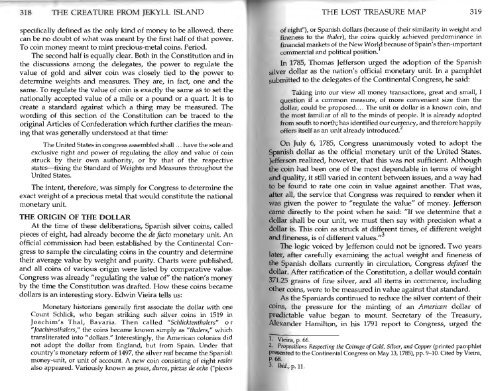You also want an ePaper? Increase the reach of your titles
YUMPU automatically turns print PDFs into web optimized ePapers that Google loves.
318 THE CREATURE FROM JEKYLL ISLAND<br />
specifically defined as the only kind of money to be allowed, there<br />
can be no doubt of what was meant by the first half of that power.<br />
To coin money meant to mint precious-metal coins. Period.<br />
The second half is equally clear. Both in the Constitution and in<br />
the discussions among the delegates, the power to regulate the<br />
value of gold and silver coin was closely tied to the power to<br />
determine weights and measures. They are, in fact, one and the<br />
same. To regulate the value of coin is exactly the same as to set the<br />
nationally accepted value of a mile or a pound or a quart. It is to<br />
create a standard against which a thing may be measured. The<br />
wording of this section of the Constitution can be traced to the<br />
original Articles of Confederation which further clarifies the meaning<br />
that was generally understood at that time:<br />
The United States in congress assembled shall . . . have the sole and<br />
exclusive right and power of regulating the alloy and value of coin<br />
struck by their own authority, or by that of the respective<br />
states—fixing the Standard of Weights and Measures throughout the<br />
United States.<br />
The intent, therefore, was simply for Congress to determine the<br />
exact weight of a precious metal that would constitute the national<br />
monetary unit.<br />
THE ORIGIN OF THE DOLLAR<br />
At the time of these deliberations, Spanish silver coins, called<br />
pieces of eight, had already become the de facto monetary unit. An<br />
official commission had been established by the Continental Congress<br />
to sample the circulating coins in the country and determine<br />
their average value by weight and purity. Charts were published,<br />
and all<br />
coins of various origin were listed by comparative value.<br />
Congress was already "regulating the value of" the nation's money<br />
by the time the Constitution was drafted. How these coins became<br />
dollars is an interesting story. Edwin Vieira tells us:<br />
Monetary historians generally first associate the dollar with one<br />
Count Schlick, who began striking such silver coins in 1519 in<br />
Joachim's Thai, Bavaria. Then called " Schlicktenthalers" or<br />
"joachimsthalers," the coins became known simply as "thalers," which<br />
transliterated into "dollars." Interestingly, the American colonies did<br />
not adopt the dollar from England, but from Spain. Under that<br />
country's monetary reform of 1497, the silver real became the Spanish<br />
money -unit, or unit of account. A new coin consisting of eight teaks<br />
also appeared. Variously known as pesos, duros, piezas de ocho ("pieces<br />
THE LOST TREASURE MAP 319<br />
of eight"), or Spanish dollars (because of their similarity in weight and<br />
fineness to the thaler), the coins quickly achieved predominance in<br />
financial markets of the New World because of Spain's then-important<br />
commercial and political position.<br />
In 1785, Thomas Jefferson urged the adoption of the Spanish<br />
silver dollar as the nation's official monetary unit. In a pamphlet<br />
submitted to the delegates of the Continental Congress, he said:<br />
Taking into our view all money transactions, great and small, I<br />
question if a common measure, of more convenient size than the<br />
dollar, could be proposed.... The unit or dollar is a known coin, and<br />
the most familiar of all to the minds of people. It is already adopted<br />
from south to north; has identified our currency, and therefore happily<br />
offers itself as an unit already introduced.<br />
On July 6, 1785, Congress unanimously voted to adopt the<br />
Spanish dollar as the official monetary unit of the United States.<br />
Jefferson realized, however, that this was not sufficient. Although<br />
the coin had been one of the most dependable in terms of weight<br />
and quality, it still varied in content between issues, and a way had<br />
to be found to rate one coin in value against another. That was,<br />
after all, the service that Congress was required to render when it<br />
was given the power to "regulate the value" of money. Jefferson<br />
came directly to the point when he said: "If we determine that a<br />
dollar shall be our unit, we must then say with precision what a<br />
dollar is. This coin as struck at different times, of different weight<br />
and fineness, is of different values."<br />
The logic voiced by Jefferson could not be ignored. Two years<br />
later, after carefully examining the actual weight and fineness of<br />
the Spanish dollars currently in circulation, Congress defined the<br />
dollar. After ratification of the Constitution, a dollar would contain<br />
371.25 grains of fine silver, and all items in commerce, including<br />
other coins, were to be measured in value against that standard.<br />
As the Spaniards continued to reduce the silver content of their<br />
coins, the pressure for the minting of an American dollar of<br />
predictable value began to mount. Secretary of the Treasury,<br />
Alexander Hamilton, in his 1791 report to Congress, urged the<br />
1- Vieira, p. 66.<br />
2. Propositions Respecting the Coinage of Gold, Silver, and Copper (printed pamphlet<br />
Presented to the Continental Congress on May 13, 1785), pp. 9-10. Cited by Vieira,<br />
P- 68.<br />
3 - Ihid., p. 11.


